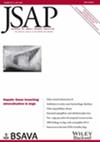Assessment of alendronate and dietary treatment in the management of feline idiopathic ionised hypercalcaemia and ionised hypercalcaemia associated with chronic kidney disease: 29 cases (2016-2022)
Abstract
Objectives
This retrospective cohort multicentre study aimed to characterise the signalment, clinicopathologic data, complications and the association between treatment and outcome (the reduction in ionised calcium concentration) in cats with idiopathic or chronic kidney disease-associated ionised hypercalcaemia managed with alendronate and standard treatment or standard treatment alone, and to compare the outcome between the two groups.
Materials and Methods
Medical records for cats diagnosed with idiopathic or chronic kidney disease-associated ionised hypercalcaemia were retrospectively reviewed. Cats treated with alendronate and standard treatment were assigned to the alendronate group and cats treated with standard treatment alone were assigned to the control group. The standard treatment was defined as dietary modification and/or monitoring of ionised calcium concentrations and management of complications secondary to hypercalcaemia. The follow-up period was selected as 6 months.
Results
Twenty-nine cats were enrolled in the study. Nine cats were included in the control group and 20 cats in the alendronate group. A significant reduction in serum ionised calcium was observed in both groups between the baseline and the follow-up visit; however, this reduction did not differ significantly between both groups (the mean change in the ionised calcium concentration in alendronate and control group was −0.18 and −0.17, respectively). Suspected bisphosphate-related osteonecrosis of the jaw was reported in one cat receiving alendronate.
Clinical Significance
In this study, similar reduction in serum ionised calcium concentration was observed in cats with ionised hypercalcaemia treated with diet alone and in cats treated with diet and alendronate. These results should be interpreted with caution, as the study was underpowered for meaningful statistical comparison. Cats receiving alendronate should be monitored for the development of adverse reactions, including osteonecrosis of the jaw.

 求助内容:
求助内容: 应助结果提醒方式:
应助结果提醒方式:


